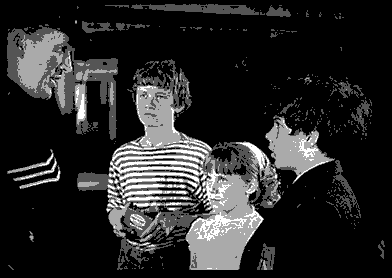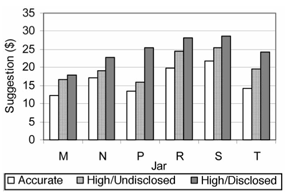« Duncan Luce | Main | Trust has a substitute? »
March 09, 2005
Honesty, No longer the best policy?
THE DIRT ON COMING CLEAN: PERVERSE EFFECTS OF DISCLOSING CONFLICTS OF INTEREST

Conflicts of interest have been at the heart of many business scandals. Investment bankers who get paid more when their clients trade more, or doctors who get paid more when their patients require more care, are both examples of advisors with a conflict of interest. The solution usually is considered to be a full disclosure of each party's conflict of interest. A recent article out of Carnegie Mellon University by Daylian Cain, Don Moore, George Loewenstein investigates to what extent the receivers of advice use this knowledge to counteract any given biases and how disclosure of conflicts affects the advice given. The authors argue such disclosure may not remedy conflicts but could possibly aggravate them.
ABSTRACT
"Conflicts of interest can lead experts to give biased advice. While disclosure has been proposed as a potential solution to this, we show that disclosure can have perverse effects, and might even increase bias. Disclosure may increase bias because advisors feel morally licensed and strategically encouraged to exaggerate their advice even further from the truth. As for those receiving the advice, proper use of the disclosure depends on understanding how the conflict of interest biased the advice and how that advice impacted them. Because people lack this understanding, disclosure can fail to solve the problems created by conflicts of interest."
QUOTES
"Perhaps, however, the benefits of disclosure should not be accepted quite so quickly. For disclosure to be effective, the recipient of advice must understand how the conflict of interest has influenced the advisor and must be able to correct for that biasing influence. In many important situations, however, this understanding and ability may be woefully lacking. For example, imagine a patient whose physician advises, "Your life is in danger unless you take medication X," but who also discloses, "The medication's manufacturer sponsors my research." Should the patient take the medication? If not, what other medication? How much should the patient be willing to pay to obtain a second opinion? How should the two opinions be weighed against each other? The typical patient may be hard-pressed to answer such questions."
"And what is the impact of disclosure on providers of advice? In the example just given, is it possible that the physician’s behavior might be affected by disclosure? For example, might the physician be more likely to exaggerate the danger of not taking the medication in order to neutralize the anticipated "warning" effect of the disclosure?"
"First, estimating the impact of a conflict of interest on an advice giver is an extraordinarily difficult problem that requires both economic and psychological insight. To properly estimate the degree to which a particular advisor is biased by a conflict of interest, one would want to know the extent to which the advisor embraces professional norms or is instead corrupt. One would also want to know how tempting the advisor finds the incentives for providing biased advice, and one would want to have an accurate mental model of how such incentives can bias advice. However, prior research suggests that most people have an incorrect understanding of the psychological mechanisms that transform conflicts of interest into biased advice."
"Research on what has been called the “failure of evidentiary discreditation” shows that when the evidence on which beliefs were revised is totally discredited, those beliefs do not revert to their original states but show a persistent effect of the discredited evidence (Skurnik, Moskowitz, and Johnson 2002; Ross, Lepper, and Hubbard 1975). Furthermore, attempts to willfully suppress undesired thoughts can lead to ironic rebound effects, in some cases even increasing the spontaneous use of undesired knowledge (Wegner 1994)."
"Disclosure, at least in the context of the admittedly stylized experiment discussed in this paper, benefited the providers of information but not its recipients. To the extent that a similar effect occurs outside the experimental laboratory, disclosure would supplement existing benefits already skewed toward information providers. In particular, disclosure can reduce legal liability and can often forestall more substantial institutional change. We do not believe that this is a general result—that is, that disclosure always benefits providers and hurts recipients of advice—but it should challenge the belief that disclosure is a reliable and effective remedy for the problems caused by conflicts of interest."
EXPERIMENTAL METHOD
"The estimation task involved estimating the values of jars of coins. Estimators were paid according to the accuracy of their estimates, and advisors were paid, depending on the experimental condition, on the basis of either how accurate or how high (relative to actual values) the estimators' estimates were.
In each round, advisors took turns at closely examining a jar of coins and then completed an advisor's report. Each advisor's report contained the advisor's suggestion of the value of the jar in question and provided a space in which the estimator would respond with an estimate of the jar's worth.
After seeing the reports, the estimators saw the jar in question -- but only from a distance of about 3 feet and only for about 10 seconds: the experimenter held the jar in front of estimators, turning the jar while walking along a line across the room and back. Estimators then attempted to estimate the value of the coins in the jar.
The amount of money in each of the six jars (M, N, P, R, S, and T) was determined somewhat arbitrarily to lie between $ 10 and $ 30, and advisors were informed of this range. Estimators were told that advisors had information about the range of actual values but were not given this range of values themselves. In fact, the values of the jars were M = $ 10.01, N = $ 19.83, P = $ 15.58, R = $ 27.06, S = $ 24.00, and T = $ 12.50. In the first three rounds, neither estimators nor advisors received feedback about their actual payoffs or about actual jar values. In each of the last three rounds, however, after advisors had given their advice and estimators had made their estimates, each advisor was shown the estimate of the estimator to whom their advice was given on the previous jar and, for each of the feedback rounds, the actual value of the jar in question was announced to everyone at the end of the round. Since payoff schedules were provided to all participants at the beginning of the experiment, feedback allowed both advisors and estimators to calculate how much money they had made in the previous round before continuing on to the next round. While estimators did not see the advisor's instructions, advisors saw a copy of the estimator's instructions and thus could also use feedback to calculate their estimator's payoffs.
Both estimators and advisors were paid on the basis of the estimator's estimates. Estimators were always paid on the basis of the accuracy of their own estimates. Advisors' remuneration depended on the condition to which they were assigned. In the "accurate" condition, each estimator was paid according to how accurate the estimator's estimate was, and this was disclosed prominently on the advisor's report immediately under the advisor's suggestion. ("Note: The advisor is paid based on how accurate the estimator is in estimating the worth of the jar of coins.") In the "high/undisclosed" and "high/disclosed" conditions, each advisor was paid on the basis of how high the estimator's estimate was. This conflict of interest was not disclosed in the high/undisclosed condition but was prominently disclosed in the high/disclosed condition, immediately under the advisor's suggestion. ("Note: The advisor is paid based on how high the estimator is in estimating the worth of the jar of coins.") In addition to being remunerated on the basis of their estimators' estimates, all advisors had an additional opportunity to earn money: after they had completed the report for each jar, advisors were asked to give their own personal best estimates of the true value of the coins in the jar and were rewarded on the basis of accuracy."

Advice provided for each jar, by condition
ABOUT THE AUTHORS
Daylian Cain

"I am a 4th year doctoral student at Carnegie Mellon University's Tepper School of Business, (Pittsburgh, PA) where I concentrate on Organizational Behavior & Theory. My main area of interest is decision making -- both the normative aspects (as informed by Ethics and Economics) and the descriptive aspects (as informed by Social Psychology and Behavioral Decision Research). I also earned an academic background in Philosophy, where I was interested in theories of rationality and morality. These combined interests lead me to conduct research and lecture on topics such as managerial decision making, business ethics, and negotiations. "
Daylian Cain Home Page
Don Moore

Don Moore is an Assistant Professor in the Organzational Behavior and Theory group at the Tepper School of Business at Carnegie Mellon University. "The human mind, for all its miraculous power, does not come with an instruction manual. This ignorance has tremendous consequences, not only for the way we make decisions as individuals, but also for interactions (including negotiations), and for the organizations we create. My work seeks to fill important gaps in our understanding of ourselves and document the implications of these discoveries on social, organizational, and market outcomes."
Don Moore's Home Page
George Loewenstein

George Loewenstein is a professor in the Department of Social and Decision Sciences at Carnegie Mellon University. "My primary research focus is on intertemporal choice--decisions involving trade-offs between costs and benefits occurring at different points in time. Because most decisions have consequences that are distributed over time, the applications of intertemporal choice are numerous (e.g. saving behavior, consumer choice, labor supply).
In the past, formal analyses of intertemporal choice in economics and other social science disciplines have been dominated by a single model--the discounted utility model. I try to identify deficiencies with this model, explain these deficiencies in psychological terms and propose alternative models."
George Loewenstein Home Page
Posted by DSN at March 9, 2005 09:29 PM